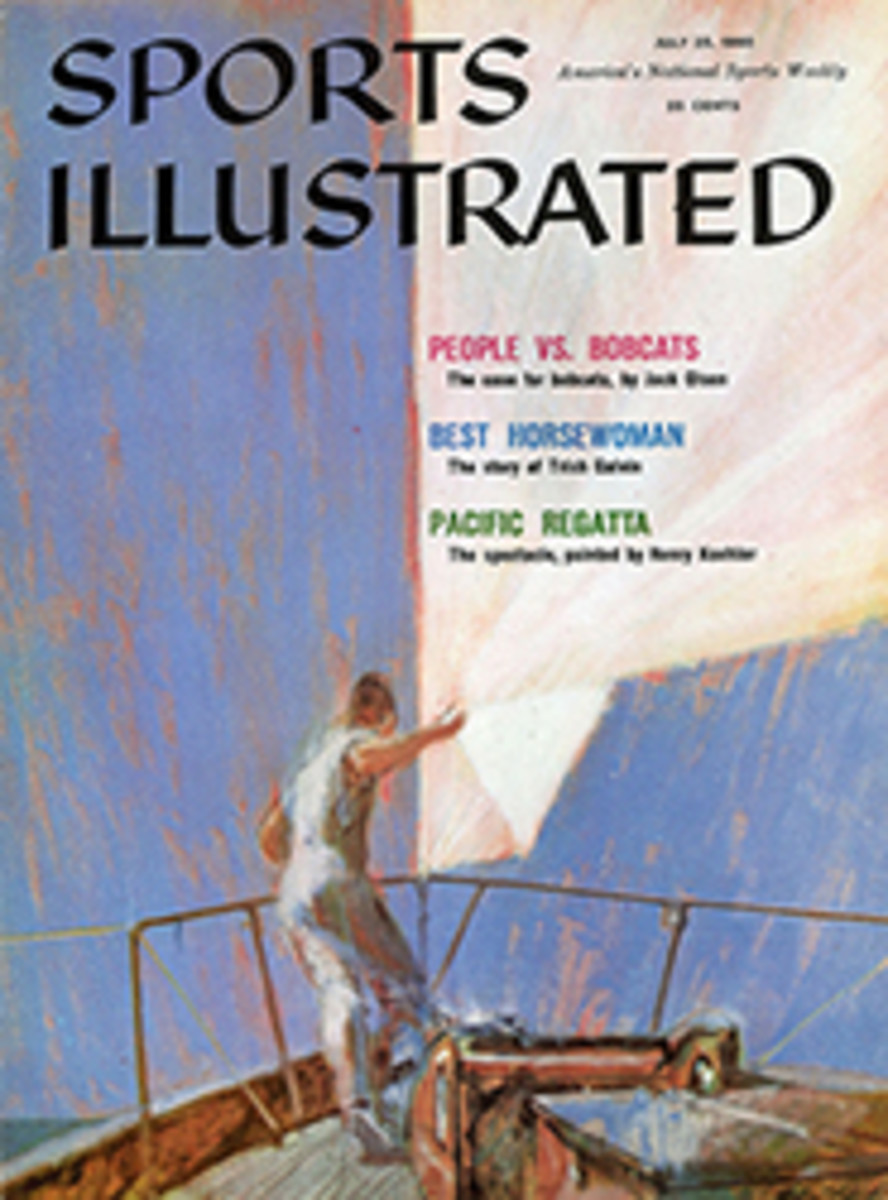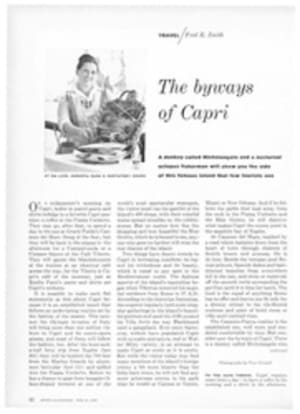
THE DELICATE MISS TRISH
The stunning young lady at the left, coolly appraising her horse, might well be a Hollywood starlet dressed for a riding part in a movie. She is, actually, Patricia (Trish) Galvin, the U.S.'s top Olympic dressage rider, and her real-life role is every bit as dramatic and as specialized as any on the screen.
Last week in Aachen, Germany at Europe's largest horse show, Trish played a triumphant scene worthy of a movie script. Before 40,000 spectators, she became the first American ever to win the Grand Prix de Dressage and the title of leading rider in the Aachen show. In so doing, she not only defeated one of her coaches, Sweden's Henri St. Cyr (a two-time Olympic champion) but, in a competition within the Aachen competition, firmly trounced her American rivals for the top place on the U.S. Olympic dressage team. The climax was wide-screen and glorious Technicolor. When Trish and her horse Rath Patrick joined the traditional farewell parade, the bands played and all 40,000 spectators waved their handkerchiefs and sang out, "Auf Wiedersehen." Trish's star billing in this demanding sport is now well assured.
Singapore-born Trish Galvin is the oldest child of widely traveled parents. Her mother, Patricia, is a British citizen and her father, John, is (as he puts it) "one of the last of a species, a citizen of the British colonies—you know, that Empire they keep giving away, although I keep protesting at every gift." The Galvins now live on a show-place ranch in the Santa Ynez mountains near Santa Barbara, Calif., although they still own homes in such places as Hong Kong and Dublin. Trish became an American citizen in 1956.
She is a small, almost fragile-appearing brunette whose reserve generally makes as pleasing an impression as her stylish riding. Behind the shining good looks and the delicate grace, however, there is great strength—strength dedicated to the hard work and long hours that horses demand. When Trish decided to go out for the Olympic team, she gave up nearly all of the social pleasures readily available to a wealthy and beautiful youngster. She once turned down a chance to be presented to England's Queen Elizabeth because it would have interfered with her training program.
In manners and early education Trish Galvin is a product of the Sacred Heart, the order of Catholic nuns whose schools and convents are established around the world. The Galvin entourage almost always includes a priest, usually Irish and knowledgeable about horses. (In addition to blessing Trish and her horse before they go into the ring, he will happily perform this same service for other competitors.) One of Trish's distant cousins was the late Bishop Edward Galvin, founder of the Columban Fathers, a missionary order of priests with headquarters in Ireland and Nebraska. The bishop, Galvin says, may be eventually investigated for elevation to sainthood.
Aside from the discipline of school, Trish studied ballet four days a week until she was 18. Then horses won her away from the dance. However, she still goes through the dance positions regularly to tone her muscles and for relaxation. It is a routine she learned from her mother, who, before her marriage, studied in Shanghai with Goncharov, the Russian ballet master responsible for such excellent ballerinas as Margot Fonteyn. This training, Trish's father believes, has given her an enormous advantage in riding. "People see Trish, so fragile looking," he says, "and they think she can't have the strength to ride well. They don't know about her training, about the leg power of a well-trained dancer. But when I see Trish's toe turn out—in a ballet position, you know—I'm sure she is giving her horse a real good squeeze."
Trish's rapid rise in a sport generally considered the special province of the older, mature horseman has left some breathless, others envious but all in agreement that her own elegance and Rath Patrick's élan make a memorable combination. In an Olympic dressage test, such as Trish won at Aachen, each rider performs individually before a panel of judges, who score without comparing notes. The ride lasts 12 minutes and includes 33 different movements performed in a rectangle 20 by 60 meters which is marked off by letters. It is the most esoteric of the equestrian arts and, to the uninitiated, the instructions read like an ancient treasure map: "Walk from H to C...halt at X and back three steps..." and so on.
But the very precision of these instructions establishes a standard of discipline, polish and fluid grace from the horse and subtle skill from the rider, whose signals to his mount are supposed to be imperceptible. Thus the test becomes the ultimate refinement of a horse's natural movements, the quintessence of training, which is what the word dressage means. Such equestrian paragons are not produced overnight, yet Trish's swift success could lead one to think so.
Trish actually turned her full attention to Grand Prix dressage only after it was apparent that she would not be able to make the U.S. Pan American or Olympic three-day team—for the simple but exasperating reason that the satraps of these sports were not about to amend their ban on female participants. She had won local fame in California horse shows in junior jumping classes after the Galvin family settled in San Francisco. (They arrived there via Australia, Hong Kong, Switzerland and Ireland.) She then started competing in West Coast three-day events, which consist of a modified dressage test, an endurance ride and stadium jumping. Good dressage horses and instruction in the art of cueing them are not readily available in California. So John Galvin, a man noted for his directness, decided that the first step was to get the best horses.
He bought Juli, on whom Henri St. Cyr had won the Olympic gold medal in Stockholm, as well as St. Cyr's second horse, Perfekt. Later he added a third St. Cyr horse to the Galvin string—Le Marquis. Simultaneously, Galvin was importing Irish-bred hunters for his daughter and other U.S. riders of his choice who lacked quality mounts. All settled in to train on Galvin's 33,000-acre ranch near Santa Barbara.
In September 1957 the Galvin entourage headed eastward to Colorado Springs for the National three-day test. There Trish gained a measure of national fame by becoming the first woman in the U.S. ever to finish the exhausting event (SI, Sept. 30, 1957). She finished fourth, sufficiently impressing her male competitors for them to present her with a special cup. All agreed she would soon be pushing them for top honors. But the following year there were two setbacks. First, it was definitely decided that women would not be eligible for the Pan American three-day event. Then, at Pebble Beach during a three-day test, Trish's mount spilled her, injuring her leg and grounding her for six weeks. John Galvin had the horse destroyed. "If Trish can't ride it," he said, "then the horse is dangerous, and I don't want anyone else hurt."
Recovered, Trish turned her full attention to Grand Prix dressage, and John Galvin continued to aid U.S. equestrians. Candidates for the Olympic team were invited to train on his ranch, extensive facilities were built and Galvin himself continued to scoop up horses of reputation that were for sale anywhere in the world.
The U.S. equestrian team suddenly had an unexpected angel. Soon Galvin horses were on all three of the riding squads. (Besides Trish's victory at Aachen, Night Owl, owned by Mrs. Galvin and ridden by George Morris, won the jumping title.) Galvin had become the man behind the USET just as his daughter was winning her place in dressage.
One thing John Galvin still wanted for Trish, and still lacked, was the perfect horse. He searched the world and then, ironically, found the animal in his adopted state. Irish-bred Rath Patrick, now Trish's favorite, was owned by Leonard Lafond, a member of the 1956 Canadian Olympic team who suffered a heart attack soon after the Games. Lafond retired to California and, unable to ride, looked around for a rider measuring up to his standards. In less time than it takes a horse to whisk off a fly, Rath Patrick and Lafond were at John Galvin's ranch and Trish was on Rath Patrick. The combination was electric.
Galvin was shrewd enough to realize, however, that perfect combinations at home can turn into fizzles in competition. For an unprejudiced and expert view, he flew France's top dressage rider, Challan-Belval, to California to judge a competition in which Trish was entered for her first public Grand Prix ride. But when Trish and Rath Patrick came into the ring a cloudburst came with them. "Every now and then," Galvin recalls, "Trish would emerge from behind a curtain of water. You couldn't even see the other end of the ring." But Challan-Belval saw enough to put Trish in first place. After watching her again the following day, without the distractions of a deluge, he agreed with Lafond and St. Cyr that Trish had that certain something it takes to make a topflight dressage rider.
Trish went on to the Pan American Games, where she was the upset winner of the dressage gold medal for the U.S., and Galvin then decided that it might be wise to discover just how she looked against the Europeans. The Rome Olympics was the next target, and Europeans traditionally have dominated Olympic dressage.
So Trish, Rath Patrick, Juli and Le Marquis went to Berlin and into the toughest of competition. Trish just plain took Berlin. On Rath Patrick she won both the S Test (S for schwer, meaning difficult) and the Grand Prix. The German press called her a princess, and a movie studio offered her a contract. In Dortmund she did not win the Grand Prix, but the audience showed how much they admired this lovely stranger. During the competition she celebrated her 21st birthday, and the spectators, 25,000 strong, stood and sang Happy Birthday.
In a few weeks Trish Galvin will be competing in Rome, the final test of her skill and the dream of her determined father. "We are," says John Galvin, "a colorful family. We're originally from Ireland, but there have been Galvins in the Pacific for years. There was a John Galvin in Texas in 1712, working for the Spanish king, but as far as I can make out, he seemed to spend most of his time trading horses." Trish's great-aunt went from Lyon, France to Cincinnati and, in 1866, rode overland to Santa Fe. "One hundred years later," says Galvin, "there is still a Galvin girl on a horse."
PHOTO
JERRY COOKE
DRESSED FOR DRESSAGE, Trish slips on her gloves and prepares to inspect Rath Patrick's tack before riding into the ring.
PHOTO
AT DUBLIN HORSE SHOW, THE GALVINS (CENTER) ADD A HORSE TO THEIR STABLE
PHOTO
IN HER FIRST BIG THREE-DAY COMPETITION AT COLORADO SPRINGS, TRISH SAILS CLEANLY OVER JUNK OBSTACLE ON BRAC NA RI

